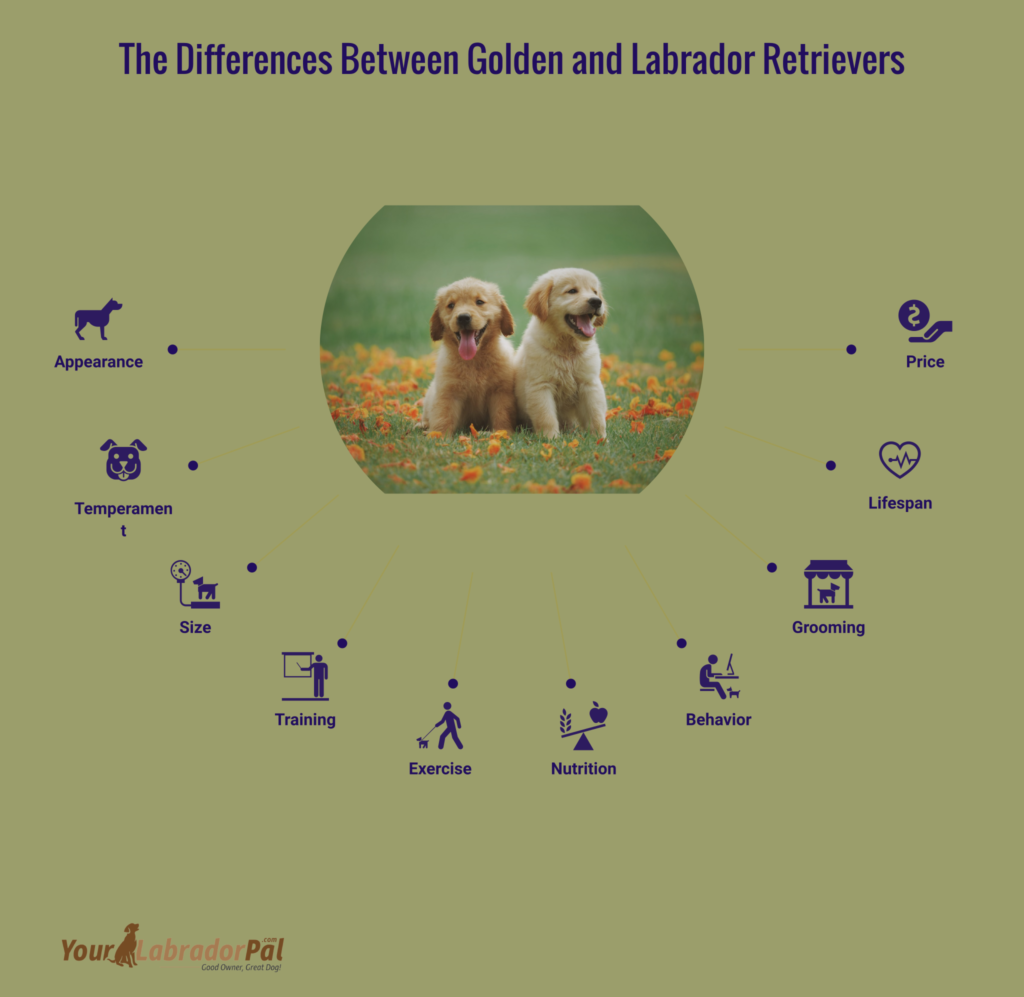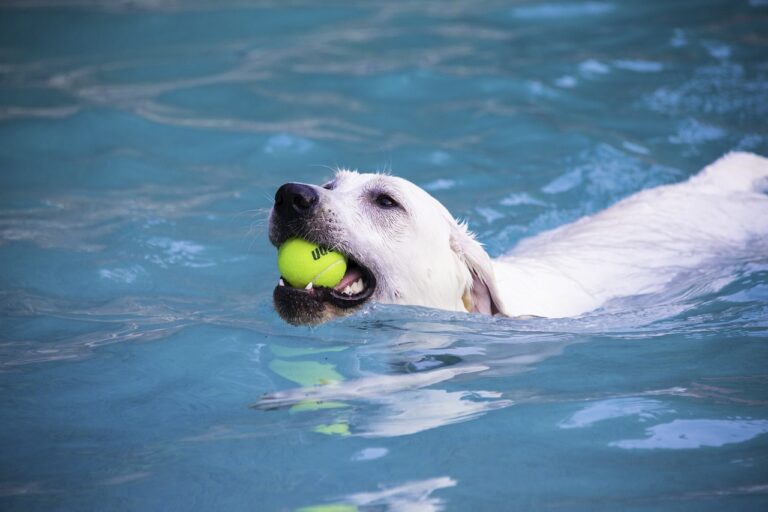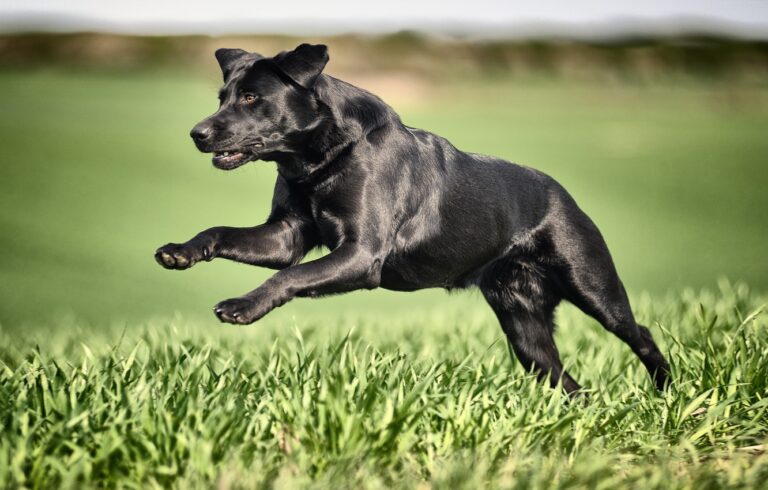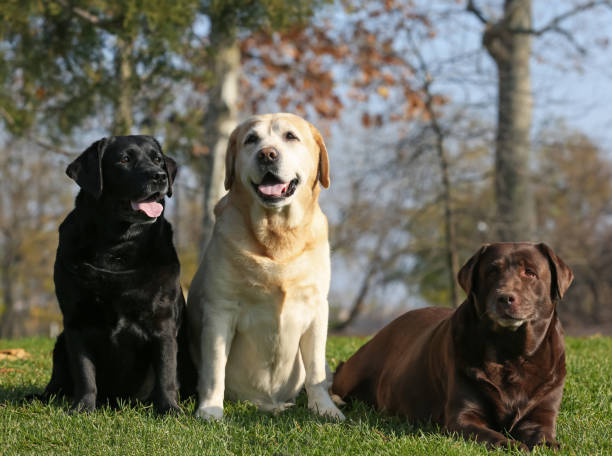What Is the Difference Between a Golden Retriever and a Labrador Retriever
Do you want to know the differences between these lovable and friendly dogs, Golden retrievers and Labrador retrievers? In this post, I will give you all the differences and characteristics of these breeds. Since they are canine relatives, many are curious about the differences between golden and Labrador retrievers. Based on the sort of function the dogs were initially intended to serve, the American Kennel Club (AKC) divides dogs into seven categories.
Among the sports breeds, the golden retriever and Labrador retriever make wonderful outdoor companions, workout partners, and family members. On the other hand, they each have different levels of energy. Compared to Labrador Retrievers, Golden Retrievers are more laid back. Like the Labrador, the Golden requires more grooming. Goldens may also be slightly less expensive when buying a puppy.
This article will examine the fundamental differences between Labrador and Golden Retrievers, behave, and how they feel physically. Whether you’re considering obtaining a new pet or are just interested in these well-known breeds, keep reading to see what makes them unique.
Golden and Labrador Retriever Breed Origin
These fascinating dogs have similar appearances, come from diverse parts of the world, and have distinct histories. These breeds were developed for equivalent working environments. And the two dogs have developed into wonderful household pets.
➣Golden Retriever
A breed of dog called the Golden Retriever was developed in Scotland in the middle of the 19th century. Lord Dudley Marjoribanks, who subsequently rose to become the first Lord Tweedmouth, created them. The Tweed Water Spaniel, & St. John’s Water Dog are among the breeds said to have been crossed to create the Golden Retriever, while their precise origin is unknown.
This breeding program’s objective was to produce a canine adept at recovering game from water and land. The American Kennel Club and the UK’s Kennel Club both granted the breed formal recognition in 1925 and 1903, respectively. Being one of the most well-liked dog breeds in the world today, Golden Retrievers are renowned for their intelligence, trainability, and kind, loyal demeanor. They used them as family pets, rescue, search, and support dogs.
Together with his polished work ethic, his elegance and attractiveness also won over the Americans. Gerald Ford, the country’s 38th president, acquired Liberty, a charming Golden Retriever, which helped the breed gain popularity. She was frequently shown on television as the ideal and cheery family pet.
➣Labrador Retriever
In the sixteenth century, Newfoundland, Canada, was the birthplace of the Labrador Retriever dog breed. The regional fishermen who required a dog to help them with their work and recover fish that had slipped off their hooks created the breed. The first canines utilized in creating the breed were a cross between regional water dogs and several European breeds, including the Newfoundland, St. John’s Water Dog, and the English Setter.
The breed was improved upon and transformed into the modern Labrador Retriever throughout time. The breed soon gained popularity as a preferred companion dog due to its superior hunting and retrieving skills. Nowadays, the Labrador Retriever is among the most well-liked dog breeds worldwide and is employed for various purposes, such as assistance dogs, search and rescue, and hunting.
The Labrador Retriever gained popularity after being brought back to Britain by visiting English nobility. Paradoxically, he is from Newfoundland, not Labrador, and ever since the English aristocrats gave him the name “Labrador Retriever,” they have been a loyal family favorite worldwide.
The Differences between Golden and Labrador Retrievers
The most well-liked dog breeds worldwide are the Labrador and Golden Retrievers, renowned for their devoted and amiable natures. They have several important differences as well as some similarities.
🐕Appearance
The Golden Retriever and Labrador Retriever seem identical to one another. They are both standard-size dogs, and the Labrador is slightly taller (24.5 inches at the withers) than the Golden (paw to shoulder). Moreover, the Labrador weighs five pounds more than the Golden Retriever on average. Comparing it to the weight of such a bag of sugar, we can see that there isn’t much difference in their weights.
Because the Golden is more slender than Labrador, he has a more elegant aspect, but the Labrador appears to be a bit beefier due in large part to his coat. To stay warm, the Golden Retriever has an undercoat and an exterior coat, but his outside coat is longer and smoother, offering them a classy appearance. The Labrador has an undercoat and an outside coat similar to other dogs. However, his outer coat is significantly shorter and denser.
Like a wetsuit, the Labrador’s coat traps body heat to keep the dog comfortable in the chilly Canadian waters. While both of their coats were water-resistant, the Labrador is more advanced since his coat also resists ice. Compared to the Golden, the Labrador has a greater range of coat colors.
Even though it comes in several hues of golden, the Golden only wears one color: golden. When a Golden Retriever reaches adulthood, his coat turns virtually white or has a dark golden red tint, but the Labrador, except for a few grey hairs, retains its color. The Golden’s long tail, which is similarly long and covered in plumes, adds to its grace since it moves side to side as it walks, exactly like human arms do.
🐕Temperament
Both Labrador and Golden Retrievers are recognized for having amiable and extroverted attitudes. Both breeds are well-liked and frequently employed as family pets, therapy dogs, and service dogs. Generally speaking, golden retrievers are sociable, wise, and loyal. They are extremely friendly canines who like interacting with people. They are excellent with kids since they are also extremely kind and patient.
Golden retrievers are well renowned for being eager to please and being simple to teach, making them excellent candidates for agility and hunting, and obedience training. Moreover, Labrador Retrievers are renowned for having extroverted and amiable attitudes. They get along well with kids and other animals and are highly sociable dogs. Their high energy and playfulness make them popular with busy families.
Labradors are extremely bright and eager to please, just like Golden Retrievers, which makes them simple to teach. Both breeds are excellent alternatives for families searching for a sociable, extroverted, and devoted companion since they have extremely similar temperaments.
🐕Size
Even though there are minor variances in their typical size and weight, Labrador and golden retrievers are both medium-sized to large-sized canines. The typical height and weight of a male Golden Retriever are 65 to 75 pounds and 23 to 24 inches (58 to 61 cm) at the shoulder, respectively (29-34 kg). Female Golden Retrievers normally weigh between 55 & 65 pounds and stand between 21.5 & 22.5 inches (55 & 57 cm) at the shoulder (25-29 kg).
Labrador Retrievers are smaller than Golden Retrievers. A male Labrador Retriever is between 65 & 80 pounds and measures 22.5 to 24.5 inches (57 to 62 cm) at the shoulder (29-36 kg). Typically, female Labrador Retrievers stand 21.5 to 23.5 inches (55 to 60 cm) tall at the shoulder and weigh 55 to 70 pounds (25-32 kg). Individual dogs can differ from these averages, and their food, activity level, and general health can all impact their weight and size.
🐕Training
Labrador and Golden Retrievers are extremely trainable breeds that effectively take to positive reinforcement training techniques. The following advice can help you train these breeds:
Early training is key: When you bring your puppy home, start training them. It will be simpler to form healthy habits the sooner you start.
Use positive reinforcement: Praise appropriate conduct with sweets, compliments, and games. Your dog will be encouraged to repeat the action if you do this.
Be consistent: Use the same orders and techniques each time you train your dog. This will make it clearer to them what you’d like them to do.
Be patient: Dogs learn at different rates, and training takes time. If your dog doesn’t immediately recognize something, try not to become irritated.
Socialize your dog: By exposing them to various people, animals, and situations, your dog will learn how to act politely under all circumstances.
Train for brief periods of time: Training sessions have to be brief (approximately 10-15 minutes) and regular (2-3 times a day). This will keep your dog’s attention and keep them from getting frustrated or bored.
Employ a range of training methods: To keep your dog interested and involved, use diverse training methods, including shaping, luring, and clicker training.
Keep in mind that training is a continuous process, so you ought to reward your dog’s excellent behavior at all times. Your Golden and Labrador Retriever may learn to behave nicely and follow instructions with time, effort, and positive reinforcement.
🐕Exercise
These two dog friends are also working canines. This indicates that they both require more activity than the normal dog. It is advised that they both exercise for Sixty minutes each day. Both breeds will take pleasure in item retrieval. You’ll buy many frisbees and balls, and both breeds will enjoy agility training. They are renowned for making excellent jogging companions. Please discuss this with your veterinarian to ensure that his joints can handle extended runs. Also, the Labrador likes to swim, so you two will have a blast playing ball in your nearby lake.
Because of his exuberant nature, the Labrador can easily grow restless. Agitated dogs tend to be destructive. If left alone at home for a long period of time, they may become agitated. And to make matters worse, he may be prone to separation anxiety. To keep them engaged while you are gone, it is ideal to leave them with toys packed with puzzles and treats.
🐕Nutrition
Both breeds have comparable nutritional needs. Each of them needs around three cups of food every day. Like any dog, your canine companion needs high-quality food to be healthy. To maintain a healthy coat, Golden Retrievers should consume premium dog chow that contains plenty of omega-3 fatty acids. Dog foods designed for energetic breeds are best for Labradors. Always seek meals with an identifiable animal protein listed as the first component.
No matter what kind of dog food you select, it must always be suitable for the animal’s age. For instance, puppy food often has a lot of calories; therefore, if he is not a puppy, avoid feeding him puppy food. Always purchase the highest-quality food that you can. Several dog food alternatives include freeze-dried, fresh, wet, and dry food.
Both breeds have a reputation for being food-focused. The Labrador is larger than the Golden Retriever; however, they may rapidly gain weight if this isn’t watched. Snacks are a terrific way to acknowledge positive behavior but use caution when serving too many Scooby snacks. Both of these breeds should avoid gaining excess weight. They are more likely to develop diabetes as a result, as well as overuse injuries to their joints, muscles, and bones.
🐕Behavior
The Labrador and the Golden Retriever are well-known dog breeds with amiable and lively attitudes. These two breeds share a lot of characteristics despite having minor behavioral distinctions.
Golden Retrievers are generally gregarious, friendly, and extroverted. They are friendly dogs who enjoy being around people and are usually excellent with kids. They are also quite trainable and like exercises like agility, retrieving games, and obedience training. Due to their calm & gentle disposition, golden retrievers are renowned for being devoted friends and therapy dogs.
Moreover, Labrador Retrievers are renowned for having extroverted and amiable attitudes. They are bright and extremely trainable, which makes them ideal working dogs. They are highly sociable canines who love being around people and are sometimes described as “people dogs.” Hunting dogs, rescue and search dogs, & assistance dogs are all common uses for Labrador Retrievers. They are renowned for their love of the water and their prowess in the water.
For both species to remain healthy and content, daily exercise & mental stimulation are essential. If they don’t get enough activity or attention, they can be more likely to engage in harmful conduct. Both breeds have the propensity to chew on objects. Therefore it’s crucial to provide them with the right chew toys. Overall, Labrador Retrievers and Golden Retrievers are wonderful pets for households and single people searching for a social and outgoing companion.
🐕Grooming
Golden retrievers and Labradors both have two coats. They had a built-in resistance against the weather, which was necessary for Canadian winter and the Scottish Highlands. Both breeds often need to be brushed once or twice each week. Nonetheless, they need additional care during their twice-yearly shedding season.
Their undercoats develop thick, dense coats in the winter to keep them warm, and when spring and summer come, their undercoats shed. They often shed for up to three weeks, during which time you should anticipate grooming them both more frequently—about three or four times each week.
Since he requires more maintenance than just brushing, the Golden Retriever is a little more demanding than the Labrador. The Golden Retriever requires more care since his fur has longer feathers. Due to their long coats, Golden Retrievers often shed more than Labradors throughout the shedding season.
Every two months or so, he should clip the longer fur around its ears, neck, legs, paws, and tail to keep it from becoming too long. The Labrador is a little simpler to groom because he doesn’t need this additional trimming.
Due to his longer & silkier fur, the Golden Retriever requires more regular bathing and grooming. On average, a dog has to be bathed every four to six weeks. The Labrador would require a bath every six weeks, while the Golden Retriever required one every four weeks to maintain a healthy appearance.
If they become dirty in between bathing, you may keep them looking and smelling clean by using dog wipes, dry dog shampoo, or even dog perfume. Ensure you only give both of them more baths than is advised. You run the danger of destroying their natural coat oils, which can cause their skin to become dry.
🐕Lifespan
A Golden Retriever normally lives 10 to 12 years, but a Labrador Retriever typically lives 10 to 14 years. Nevertheless, this can change based on several variables, including heredity, way of life, and general health. Both species may live into their senior years if given the right care and attention. To ensure your furry buddy has a healthy and long life, it’s crucial to give them regular exercise, good food, and frequent veterinarian visits.
According to research conducted in England on 400 Labrador retrievers and 100 Golden retrievers, the median age at death for both breeds was 12.5 years. What about cancer prevalence, which we are aware is a problem with Goldens?
There appears to be a divide among Golden Retrievers, with some succumbing to disease far too young and those avoiding the cancer gene living considerably longer. The lifetime of your puppy’s forebears should thus be carefully considered. The mother will still be a young dog, so you won’t be able to say anything about her. Yet your puppy may have a higher chance of living a long life if its grandparents have lived to be elderly and if its father is also old.
🐕Price
The cost of the two breeds varies; the Labrador retriever ranges in price from $1,000 to $2,500, while the golden retriever costs, on average, between $1,000 and $1,300. Keep in mind that purchasing from unscrupulous breeders increases the likelihood that the puppy you receive may be sickly. If you decide to purchase a puppy, be sure to request their recommended health certifications since this increases the likelihood that you will receive a healthy dog. With the greater cancer prevalence in Golden Retrievers, this is particularly crucial.
Golden and Labrador Retriever Breed Highlights
Popular dog breeds like Golden Retrievers and Labrador Retrievers are renowned for their amiable, outgoing personality and devotion to their family. These are some significant features of each breed:
The Golden Retriever
◾️They were initially developed in Scotland in the middle of the 19th century for hunting.
◾️Golden retriever are distinguished by their thick, water-resistant long, flowing golden coats.
◾️They are frequently employed as assistance dogs or in search & rescue missions since they are very clever and trainable.
◾️Because of their amiable and gentle disposition, they get along well with youngsters and make fantastic family pets.
◾️They thrive in households with a lot of outdoor areas and need regular exercise and care.
The Labrador Retriever
◾️They were first developed as working dogs for the fisherman in Newfoundland, Canada, in the 1700s.
◾️Black, yellow, & chocolate are the three hues that they are available in.
◾️They are frequently employed as guide dogs or even for hunting and game retrieval since they are very clever and trainable.
◾️Labrador retriever don’t need much grooming because their thick, water-resistant coat sheds gently.
◾️They are well-recognized for being gregarious and sociable and get along well with kids and other animals.
◾️While they are active and need frequent exercise, they may easily adapt to a variety of living arrangements, including flats.
Golden and Labrador Retriever Health Issues
Both Labrador and Golden retrievers are healthy breeds of canine. Yet, there will be health issues to watch out for that might run in their families, just as with any dog. These health issues might or might not be inherited by either breed. The following medical issues are more likely to affect both breeds:
🔎Joint Problems
Many Labs experience joint issues such as dysplasia in the hip or elbow. These illnesses damage the elbow or hip joints, making it difficult to move normally and resulting in discomfort and immobility. The symptoms of dysplasia are decreased when your dog keeps a healthy body weight, eats a high-quality diet with lots of nutrients and vitamins, and participates in an appropriate low-impact activity, even if the condition cannot be completely prevented (swimming is ideal).
Also, several supplements are designed expressly for canine joint issues, but since their effectiveness has yet to be properly investigated, it’s advisable to speak with a doctor before using them.
🔎Obesity and Bloating
For many dogs, especially Labs, obesity is a widespread issue. Fortunately, it is pretty simple to avoid; keep an eye on your dog’s eating patterns and make sure he doesn’t overeat or eat too quickly when it’s time for meals or a snack. You might need to ration his food to prevent your dog from overheating. Bloat often refers to extra water weight in people, which is typically a benign ailment. Nevertheless, “bloat” is a dangerous medical condition that might even be lethal in lab animals.
It describes a twisted or bloated stomach that has caused a distended abdomen. Although the cause of bloat hasn’t been identified, experts concur that you shouldn’t allow your dog to overeat or drink excessive amounts of water to lower his risk of acquiring the ailment.
🔎Ear Infections
Large, floppy ears are a distinctive feature of labradors, giving them a silly, appealing appearance. Unfortunately, Labs are more prone to ear infections due to their huge ears, which serve as an ideal breeding ground for germs. By ensuring your dog’s ears are clean and dry (be careful to dry them after baths and swimming), frequently examining for any indications of infection, and removing any extra hair in the ears, you may prevent ear infections.
🔎Exercise-Induced Collapse
While it can affect Labradors and Golden Retrievers, this condition is not frequent. The dog may have a lack of muscle control after a period of overexertion. The signs might range from trailing their limbs while jogging to collapsing and becoming completely immobile. Rarely, the dog may pass away right away. Less serious cases might last up to 25 minutes.
If you adopt a Golden Retriever into your life, there is one terrible distinction to be aware of: He is highly susceptible to cancer. According to research from the 1990s, cancer in some form was responsible for 61% of fatalities among Golden Retrievers. According to scientists, the North American Golden gene pool underwent a genetic mutation as a result. The European Golden Retriever had a mortality rate of 38%, which was significantly lower.
It is crucial to inquire about his parent’s health because of this. Be sure there hasn’t been any family history of cancer. Responsible breeders shouldn’t cross-breed cancer-stricken dogs. Increase your chances of getting a healthy dog by exercising discretion. Make sure you are familiar with them and their symptoms, just like you would with other prospective health concerns.
See a veterinarian immediately for medical guidance if you suspect your dog may be ill or even if you are doubtful. You may also research pet insurance, which can assist in defraying certain expenses for both long-term and urgent treatment.
🔎Heart Disease
In the Labrador population, heart disease is a prevalent issue. Even the healthiest senior dogs might acquire heart disease, so preventive should focus on maintaining overall fitness. Make sure your dog has all necessary immunizations on time, eats high-quality kibble, drinks enough water, and exercises frequently. Your veterinarian could suggest a supplement like Chewable Tablets if your dog has heart problems in order to prevent congestive heart failure.
Dilated cardiomyopathy is a prevalent kind of cardiac disease in Labrador and Golden Retrievers (DCM). This is a disorder where the heart enlarges and weakens, making it challenging for the heart to pump blood adequately. Coughing, breathing problems, exhaustion, and fainting are some of the signs of DCM.
Subvalvular aortic stenosis is another cardiac condition that can afflict Golden Retrievers (SAS). This congenital cardiac condition causes the aortic valve to constrict, limiting blood flow and eventually resulting in heart failure. SAS symptoms might include exhaustion, coughing, and breathing issues.
Heart disease is a dangerous ailment that may affect any breed of dog, but due to their popularity as well as the fact that they are frequently employed as service dogs or for other essential duties, Golden Retrievers & Labrador Retrievers are particularly at risk. Working closely with the vet to monitor your pet’s heart health & take precautions to avoid or treat any potential cardiac issues is crucial if you own a Labrador or Golden Retriever.
🔎Progressive Retinal Atrophy
A category of genetic eye conditions known as progressive retinal atrophy (PRA) causes the retina to deteriorate gradually and finally go blind. Both Labrador and Golden Retrievers are prone to PRA, albeit each breed is affected by various forms of the disease. Typically, a mutation in the PRGRIP1 gene—which is necessary for the healthy operation of the photoreceptor cells in the retina—causes PRA in Golden Retrievers.
The name of this PRA type is GR-PRA1. A mutation in the SLC4A3 gene brings on a different form of PRA known as GR-PRA2 that affects Golden Retrievers. A mutation in the PRCD gene, which is also in charge of ensuring that the photoreceptor cells within the retina function normally, is what causes PRA in Labrador Retrievers. Prcd-PRA is the name given to this kind of PRA.
Both GR-PRA1 & prcd-PRA are autosomal dominant genetic diseases, meaning a dog must inherit two copies of the defective gene (one from each parent) to acquire the condition. Dogs with just one copy of the mutant gene are called carriers since they do not exhibit illness signs but can spread the mutation to their progeny.
Frequently Asked Questions
Which Labrador color is best?
The widespread consensus within the shooting community is that black is the best labrador color, with yellow and chocolate exclusively reserved for the show bench. In the shooting range and throughout trials, black has always dominated.
Which breed, a golden retriever or a labrador, is smarter?
Labradors and Golden Retrievers are quite intelligent, but Golden Retrievers come out on top regarding intelligence. Experts rank Golden retrievers as the fourth most intelligent breed of dog, whereas Labradors are the seventh most intelligent breed.
Do golden retrievers and Labradors look alike?
They are both retriever breeds with long tails, folded ears, webbed paws, and a love of the water. Moreover, both breeds have waterproof coats. The longer, wavy coat of a Golden Retriever requires more maintenance than that of the shorter-haired Labrador (every 2-3 days).
Can golden Labradors make good pets?
Because of their sensitive and loving disposition, they make wonderful companions and service dogs. Labradors get along well with both single owners and families, as well as with kids and other animals. They can easily handle the stress of modern life since they are enthusiastic and generally calm.
Are Labradors intelligent dogs?
Regarding the smartest dog breeds in the world, labradors, in general, come in at number seven. The black Labrador has a lengthy history of being developed specifically for its hunting-related genes across many generations. As a result, hunters are drawn to them because of their instinct and intellect.
Final Thoughts
These two breeds are wonderful additions to households. Whether you are looking for a Labrador Retriever or a Golden Retriever, you will surely find a dog that everyone will appreciate when you bring it home. Remember that you may always adopt a combination of the two breeds if you can’t decide between them. The decision between a golden retriever and a Labrador retriever may come down to individual preference & lifestyle since both types make terrific pets and friends. Whatever breed you choose, these dogs will undoubtedly enrich their owners’ lives with love and delight. Do you want to know how often should a labrador be bathed? Click Here!










